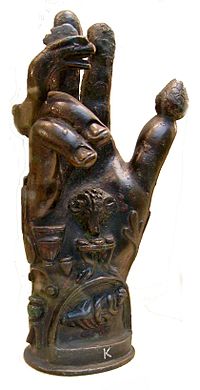
Sabazios (Ancient Greek: Σαβάζιος, romanized: Sabázios, modern pronunciation Savázios; alternatively, Sabadios[3]) is a deity originating in Asia Minor.[4] He is the horseman and sky father god of the Phrygians and Thracians.[5]
Sabazios gained prominence across the Roman Empire, particularly favored in the Central Balkans due to Thracian influence. Scholarly debate has long debated Sabazios' origins, with current consensus leaning towards his Phrygian roots.[4]
Though the Greeks interpreted Phrygian Sabazios[6] as both Zeus and Dionysus,[7] representations of him, even into Roman times, show him always on horseback, wielding his characteristic staff of power.
- ^ "British Museum Collection". britishmuseum.org. Retrieved 2017-03-06.
- ^ "British Museum Collection". britishmuseum.org. Retrieved 2017-03-06.
- ^ Rudy, Stephen, ed. (14 December 2010). Contributions to Comparative Mythology: Studies in Linguistics and Philology, 1972-1982. Walter de Gruyter. p. 7. ISBN 978-3-11-085546-3.
- ^ a b Vitas, Nadežda Gavrilović (2021). Ex Asia et Syria: Oriental Religions in the Roman Central Balkans. Archaeopress. pp. 77–91. doi:10.2307/j.ctv1gt94hj. JSTOR j.ctv1gt94hj.
- ^ Parker, Robert (7 March 2016). "Sabazius". Oxford Classical Dictionary.
- ^ Variant spellings, like Sawadios in inscriptions, may prove diagnostic in establishing origins, Ken Dowden suggested in reviewing E.N. Lane, Corpus Cultis Jovis Sabazii 1989 for The Classical Review, 1991:125.
- ^ See interpretatio Graeca.